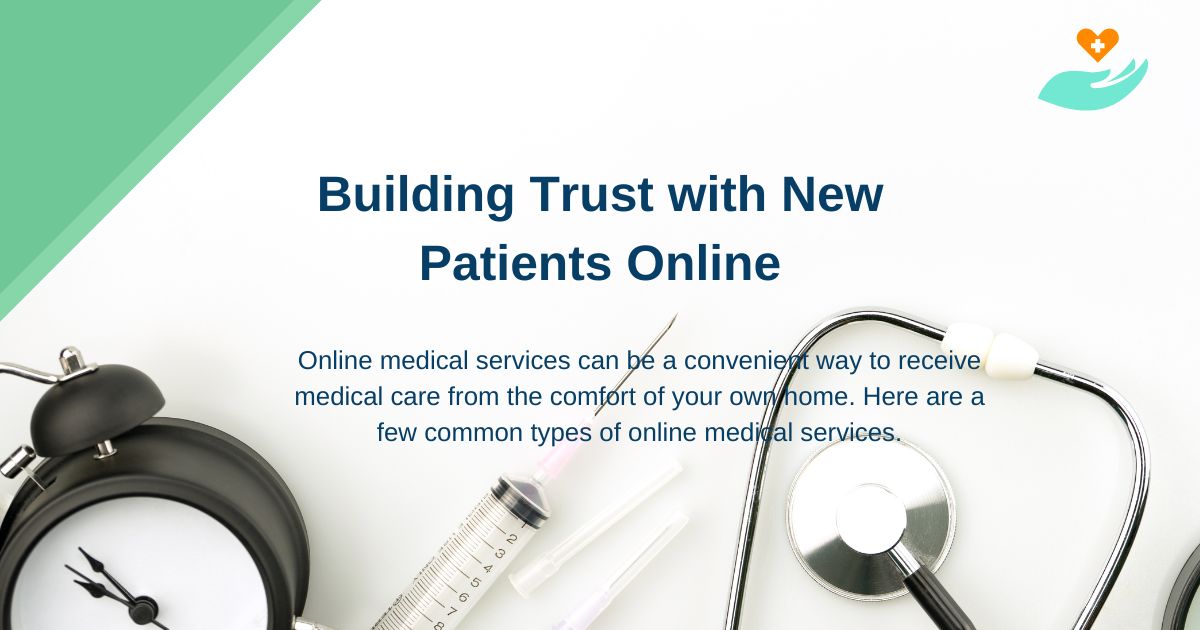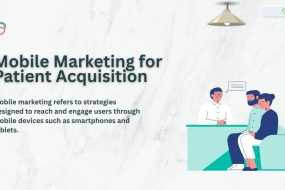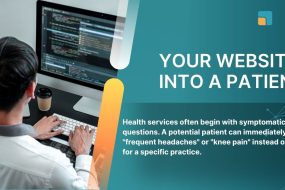
When potential patients search for health professionals online, they face a weak decision. They look at someone to trust their health, good and often with their most personal concerns. Your digital appearance will be the first impression that determines whether they will choose your practice or continue to search elsewhere.
The trust building in the health care system has evolved beyond the recommendations on the mouth. Patients are now doing large -scale online research before making appointments. They read the assessments, examine credentials and evaluate your digital appearance to determine if you are perfect for their needs. This change means that your online reputation directly affects the growth and success of your practice.
This guide discovers proven strategies to create self -confidence with new patients through your digital appearance. You want to know how to make online materials, manage your reputation effectively and establish credibility that converts visitors to the site of loyal patients.
Why Online Trust Matters More Than Ever
The health care decisions feel deeply individual. Patients want to feel safe on their supplier before entering an office. Your online appearance acts as their previous consultation, which helps them discover your expertise, the bed by the bed and the vocational values.
Research shows that patients spend important time researching the web on health professionals. They go to many websites, compare credentials and read patients’ test tours before making decisions. This digital research phase has become an important part of the patient journey.
Building Trust Online also helps you stand in competing markets. When patients can choose between dozens of suppliers, people with a strong digital trust signal receive a significant advantage. Your online reputation becomes a big difference that affects patient collection and storage.
Essential Elements of a Trust-Building Website
Your website serves as your digital front door. It needs to communicate professionalism, expertise, and genuine care for patients. Several key elements work together to create this trustworthy first impression.
Professional Design and User Experience
Clean, modern website design immediately signals professionalism. Patients associate well-designed websites with quality care. Your site should load quickly, display properly on mobile marketing for patient acquisition devices, and offer intuitive navigation that helps visitors find information easily.
Consider your color scheme, typography, and imagery carefully. Medical websites benefit from calming colors and professional photography. Avoid stock photos that look generic or outdated. Instead, use high-quality images of your actual office and team members when possible.
Clear Provider Credentials and Qualifications
The principal of your education, certificate and professional affiliation. Create a broad “” section “a section that highlights the fields in the background, training and competence. Include information about your medical school, housing, fellow and special training.
Board certificates are particularly noticeable. These credentials provide immediate reliability and help patients understand your ability. Consider creating a dedicated identification that explains what your certificate means and why they mean something to patient care.
Patient-Focused Content
Create content that addresses common patient concerns and questions. This demonstrates your expertise while showing genuine care for patient education. Write in clear, accessible language that patients can understand without medical training.
Consider creating condition-specific pages that explain symptoms, treatment options, and what patients can expect. This educational approach builds trust by showing your knowledge while helping patients make informed decisions about their care.
Building Credibility Through Content
Educational content serves multiple purposes in trust building. It demonstrates expertise, provides value to potential patients, and improves your search engine visibility. Well-crafted content can significantly impact how patients perceive your practice.
Educational Blog Posts
Regular blog posts on relevant health topics establish you as a knowledgeable resource. Focus on questions your patients frequently ask during appointments. This approach ensures your content addresses real concerns and provides genuine value.
Write about common conditions, treatment options, preventive care, and health maintenance. Use clear, jargon-free language that patients can easily understand. Include practical tips and actionable advice that readers can implement immediately.
Video Content and Virtual Introductions
Video content creates personal connections that text alone cannot achieve. Consider creating introduction videos where you explain your approach to patient care, discuss your background, and share your practice philosophy.
Patient testimonial videos can be particularly powerful trust builders. Real patients sharing their experiences provide authentic social proof that resonates with potential patients. Always obtain proper consent and follow privacy regulations when creating patient content.
Frequently Asked Questions
A comprehensive FAQ section addresses common concerns and reduces barriers to scheduling appointments. Include questions about insurance, scheduling, what to expect during visits, and your practice policies.
This proactive approach to answering questions demonstrates transparency and helps patients feel more comfortable reaching out. It also reduces the workload on your staff by addressing routine inquiries upfront.
Managing Online Reviews and Reputation

Online reviews significantly influence patient decisions. Most patients read reviews before choosing healthcare providers, making reputation management a critical trust-building activity.
Encouraging Positive Reviews
Develop a systematic approach to requesting reviews from satisfied patients. This might include follow-up emails after appointments, reminder cards with review site links, or staff training on when and how to request reviews appropriately.
Make the review process as simple as possible for patients. Provide direct links to your preferred review platforms and clear instructions on how to leave feedback. Consider creating a dedicated page on your website with links to multiple review sites.
Responding to Reviews Professionally
Respond to all reviews, both positive and negative, in a professional manner. Thank patients for positive feedback and address concerns raised in negative reviews. Always maintain patient privacy and avoid discussing specific medical details in public responses.
Your responses to reviews demonstrate your commitment to patient satisfaction and professionalism. Even negative reviews can become trust-building opportunities when handled thoughtfully and professionally.
Monitoring Your Online Reputation
Regularly monitor review sites, social media mentions, and search results for your practice. Set up Google Alerts for your name and practice to stay informed about new online mentions. Quick response to reviews and mentions shows active engagement with patient feedback.
Consider using reputation management tools that aggregate reviews from multiple platforms and provide analytics on your online reputation trends. This data helps you identify areas for improvement and track your progress over time.
Social Media and Community Engagement
Social media platforms offer opportunities to build trust through regular interaction with your community. These platforms allow you to share your expertise, showcase your practice culture, and engage with patients in more casual settings.
Sharing Educational Content
Use social media to share health tips, educational articles, and practice updates. This consistent sharing of valuable content keeps your practice top-of-mind while demonstrating ongoing commitment to patient education.
Consider creating content series that address seasonal health concerns, preventive care tips, or explanations of common procedures. This regular content creation establishes you as a reliable source of health information.
Highlighting Practice Culture
Share behind-the-scenes content that showcases your team and practice culture. This might include staff spotlights, office updates, or participation in community events. This humanizes your practice and helps patients feel more connected to your team.
Be authentic in your social media presence. Patients can sense genuine care and authenticity, which builds stronger trust than overly polished marketing messages.
Technology and Communication Tools
Modern patients expect convenient, efficient communication options. Implementing user-friendly technology demonstrates your commitment to patient convenience and can significantly impact trust levels.
Online Scheduling Systems
Offer online appointment scheduling that works smoothly and provides immediate confirmation. This convenience factor removes barriers to care and demonstrates respect for patients’ time and preferences.
Ensure your scheduling system integrates well with your website and provides clear information about available appointment types, preparation instructions, and what to expect during visits.
Patient Portals and Communication
Secure patient portals provide convenient access to test results, appointment scheduling, and communication with your office. These tools demonstrate transparency and give patients more control over their healthcare experience.
Train your staff to use these communication tools effectively and respond promptly to patient inquiries. Quick, helpful responses through patient portals can significantly enhance trust and satisfaction.
Which Should You Prioritize? Patient Acquisition vs Patient Retention
Measuring Trust and Engagement

Track Matrix that indicates success with trust building. These may include telehealth patient engagement calculations for websites, review points, patient storage speeds and referral patterns. Regular measurement helps you identify what works and in areas that require improvement.
Think of new patients conducting the decision on the decision -making process and what factors affected the practice of the practice. This response provides valuable insights into what strategies for trusting are the most effective for your specific patient population.
Your Path to Digital Trust
Trust building with new patients online requires frequent effort in many touch points. Your site, content, review and presence of social media all work together to create an overall impression of your practice and expertise.
Start by revising your current online appearance. Identify the intervals in the possibilities left for credibility signals, chronic materials or patient training. Prioritize the reforms that will have the greatest impact on patient confidence and engagement.
Remember that the trust building is a continuous process, not a time project. Regular material construction, active review management and continuous patient communication all contribute to success. Be aware of authentic, patient -centered approaches that patients show real care for goodness and satisfaction.


















No Comments